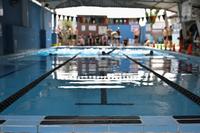There is nothing quite like running in soft sand during special ops training like Basic Underwater Demolition/SEAL (BUD/S) Training, RECON or any other amphibious operating commando training to make you realize how difficult it is to run this way. These moments of truth will make you realize that you should have prepared more by making running harder.
Much of the attrition and failure rate in these programs is simply due to running in this unforgiving way. However, not everyone has a beach to help with the transition of normal running to soft sand beach or desert running.
Here is a list of ways you can prepare yourself better for the challenges of sand running events if you are considering a military career in amphibious operations.
Find a Hill
One of the best ways to prepare for soft sand running is to find a decent hill to run up and walk or jog down. We personally use a local hill with a rise that is about 400 meters long and an incline of about 10-15 degrees. It is just enough to make running 400 meters much harder. Parking garages often have comparable inclines to that level and make a useful running tool.
Lots of Lunges
Making sure you can do multiple sets of high-volume lunges per leg will also help you when running gets harder than normal. Lung and leg development are crucial to success when running in a challenging situation. Lunges will help you build the muscle stamina needed for soft sand running and for walking lunges with a log in a chest-carry position. You should definitely add lunges to your leg days.
Stairs or Stair Stepper
If no hills or sand are available, find a tall flight of stairs or use a stair stepper machine to build the leg durability and endurance needed for carrying loads and trudging through difficult terrain whether running, rucking, or carrying boats and logs.
Treadmill Incline Workouts
Making running harder can also be accomplished by increasing the incline of a treadmill, whether at a moderate sustainable pace or a fast sprint pace interval. Both options will help make you durable enough to handle harder running terrain.
High Resistance Bike Training
Are you having issues with impact pains in your shins? No worries. You can still work the legs with high resistance Tabata Intervals (20-second sprint, 10 seconds easy) or Pyramid resistance workouts where every minute on the minute you increase the resistance of your stationary bike. Consider these high-resistance biking workouts if you cannot run as much as you would like.
Find a Plowed Field
Something I did when I went home was bike out to a local farm and ask the owners whether I could run the perimeter of a field they had just plowed. It was not ideal, but it made running harder. You will definitely need combat boots for the ankle support.
Low Water Lake or Dried-Up River Bed
When the water is lower than normal, perhaps in the middle of the summer months, see if there is a lower-than-normal lake or river bed with exposed sand. Over the years of preparing for these types of runs, I found a few dried river beds that simply made running harder for me. It worked well.
No. 1 Running in Sand Tip
Find the footprints of those in front of you. If you are committed to staying in the pack of runners in your class, glue yourself to a good runner and step into the steps made by that runner. This is a game changer. Sometimes it works out that you have those prints to help your stride and sometimes you do not. Know how to handle both situations.
The best option is to make your leg days a little harder by mixing in calisthenics or moderate weight activities to make running more difficult. Running on tired legs and getting used to that level of energy output is going to help you with rucking, running in sand, and other load-bearing activities.
A combination of strength and durability with your running endurance is the key to being physically prepared for a challenge that makes even the best runners doubt their decisions to serve in occupations that combine land and maritime operations.
Find ways to top off your leg days to make your lower body more durable for running in sand, rucking, and swimming with fins. In fact, treat harder-than-normal running as leg days and limit them to 2-3 times a week at a maximum.
-- Stew Smith is a former Navy SEAL and fitness author certified as a Strength and Conditioning Specialist (CSCS) with the National Strength and Conditioning Association. Visit his Fitness eBook store if you're looking to start a workout program to create a healthy lifestyle. Send your fitness questions to stew@stewsmith.com.
Want to Learn More About Military Life?
Whether you're thinking of joining the military, looking for fitness and basic training tips, or keeping up with military life and benefits, Military.com has you covered. Subscribe to Military.com to have military news, updates and resources delivered directly to your inbox.


















